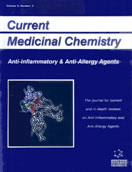Abstract
Interleukin-8 (CXCL8) belongs to the CXC branch of chemokine family and is primarily involved in the directed migration and functional activation of polymorphonuclear neutrophil leukocytes (PMNs). CXCL8 achieves its cellular effects by direct interaction with cell surface receptors (CXCR1 and CXCR2). CXCL8 is supposed to play a pivotal role in the pathology of several inflammatory diseases and this makes CXCL8 and its receptors attractive therapeutic targets. The first aim of this review is to discuss the potential pathophysiological role of CXCL8 in different pathologies, such as ischaemia / reperfusion injury, psoriasis, cystic fibrosis, and cutaneous melanoma. CXCL8 inhibitors, including a monoclonal neutralizing antibody of CXCL8, and small organic molecules which selectively inhibit CXCL8 receptor binding, will be reviewed. Finally, the ability of some non-steroidal anti-inflammatory drugs (NSAIDs) to inhibit CXCL8-induced PMN chemotaxis will also be discussed.
Keywords: CXCL8, melanoma, non-steroidal anti-inflammatory drugs (NSAIDs), PMN chemotaxis
 13
13

